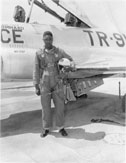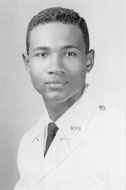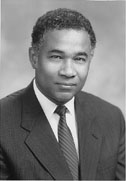
He exemplifies the trials and highlights the successes of the pioneering black students at Tech.
by Peter Wallenstein
Charlie L. Yates graduated in 1958, one of six honors graduates in mechanical engineering at Virginia Tech that year. The only African American in his class of 911 undergraduates, he was the first of his race to graduate from Virginia Tech. In fact, nowhere in the former Confederacy did a black undergraduate spend four years at a historically white institution and earn a bachelor's degree before Yates did.
Yates was not the first black student to attend Virginia Tech. Irving L. Peddrew III, admitted in 1953 -- the year before Yates -- made Virginia Tech the first historically white, four-year, public university in the former Confederacy to admit a black undergraduate. During his first year, Peddrew was the only African American among 3,322 students. He felt wretchedly isolated and left after his third year.
Yates himself graduated without ever being permitted to room on campus, and he vividly recalls the only time an exception was made to allow him to eat on campus. He was in the corps of cadets, and one time when he pulled guard duty at mealtime, "There I was in the dining hall," he says, "off to myself, eating a meal."
 |
Yates is back at his alma mater after earning a master's degree from Cal Tech and a Ph.D. from Johns Hopkins. Since 1987, he has served on Virginia Tech's aerospace engineering faculty, after first returning to Virginia Tech in 1979 to teach mechanical engineering for four years. Yates also served a term on the Virginia Tech Board of Visitors.
He exemplifies the trials and highlights the successes of the pioneering black students at Tech. |
| Charlie L. Yates in 1957 |
| In the aftermath of U.S. Supreme Court decisions handed down in 1950, Virginia authorities recognized that black Virginians, if academically qualified, must be admitted if they applied to programs of study not available at Virginia State College, the state's black land-grant school in Petersburg. That meant that black applicants for graduate and professional study could not be rejected on racial grounds. Thus the first black student admitted to the University of Virginia -- Gregory Swanson, admitted under court order in 1950 -- studied law. | |
| Charlie L. Yates is now an associate professor of aerospace and ocean engineering at Virginia Tech. He became Tech's first black alumnus in 1958. |
But the court ruling could also govern the admissions process for undergraduate programs. And thus the first black students to enroll at Virginia Tech -- among them Irving Peddrew in 1953, Charlie Yates in 1954, Matthew Winston in 1955, and Essex Finney in 1956 -- studied engineering, a subject unavailable at Virginia State.
The University of Virginia admitted its first black undergraduates, three engineering students, in 1955. Schools offering programs available at Virginia State could wait much longer to enroll black students. The College of William and Mary admitted its first black undergraduate in 1963; Longwood College, the last to desegregate, did so in 1971.
The pioneer black students at Virginia Tech understood that they did not have the option their white classmates had, to switch out of engineering yet remain at school. They took the language of their acceptance letters literally when they were told, as Essex Finney was, "We have decided that we can accept you at VPI [Virginia Tech was formerly known as VPI] . . . to take our course in agricultural engineering."
 |
The process of racial desegregation at Virginia, though slow and grudging, was far quicker and smoother than in Virginia's elementary and secondary schools, and it was far smoother and more peaceful than the desegregation of Deep South colleges and universities. In Virginia, no state governorstood in the schoolhouse door to prevent integration of a public university, and no federal troops had to accompany the enrollment of black students.
It is to Virginia Tech's credit that, unlike many schools, it did not wait until a federal court order forced admission. |
| Essex Finney in 1959 |
Yet the top administrators at Virginia's white institutions, whatever their private feelings, feared for their appropriations from the state legislature. They were fearful enough between 1950 and 1954, before the Supreme Court reversed the "separate but equal" ruling in the Brown vs. Board of Education. But after this court decision ruling, administrators saw the Virginia legislature, determined to close schools down rather than integrate, adopt massive resistance against any desegregation in the elementary and secondary schools. Leaders of higher education were not about to take the lead in desegregating their own institutions.
Tech's first black applicant wished to study business, not engineering, so the school was able to reject him. Everett Pierce Raney, who applied in 1951, wanted to continue his study at Tech after completing Virginia State's Norfolk Division's (now Norfolk State University) junior-college curriculum in business administration. Tech's president, Walter Newman, consulted the state attorney general, J. Lindsay Almond Jr., as college presidents customarily did when a black application came in. Almond noted that Virginia State offered a bachelor's degree program in business administration, so Raney had no need to go to Blacksburg.
In August 1951, President Newman received a letter from the Virginia Teachers Association, representing the black teachers of Virginia's public schools, asking Newman how Tech would treat applications from them to study there. Newman wrote back that Tech would admit qualified applicants to programs that Virginia State did not offer. Given the range of master's programs that Virginia State had inaugurated, along with the absence from either school of doctoral programs in education, Newman's letter conceded no likelihood that Tech would receive an application from an African-American teacher it could not reject.
Tech did not admit a black student, graduate or undergraduate, until 1953, when Irving Peddrew III applied for admission as a freshman to study electrical engineering. President Newman interviewed Peddrew, consulted Attorney General Almond and Gov. John Battle, and kept the board of visitors informed. He told the board that admissions interviews had reported Peddrew an acceptable student and a "very decent sort of individual."
The attorney general had made it clear to Newman that Tech had no legal leg to stand on if it wanted to reject Peddrew. The school could opt to reject Peddrew and see if he filed suit -- a suit he would surely win.
In September of 1953, Peddrew became the first black student admitted to Tech. It was a historic occasion.
Yet Peddrew was not admitted to all the school's facilities. Rather, he was defined as a "day military student," which meant he had to live and eat off campus. As a rule, day cadets were students who had obtained permission to marry and live off campus, not single students. Peddrew had been advised of the potentially difficult situation awaiting him in Blacksburg, and he assured Tech officials that he could cope. He did, at least for a time, though he left without graduating.
During 1954, Tech admitted Lindsay Cherry, Floyd Wilson, and Charlie Yates to the engineering school and the Corps of Cadets. All three were graduates of Booker T. Washington High School in Norfolk.
Wilson left after a year to enter the air force, and Cherry withdrew after three years and spent his career with the Postal Service. Yates not only graduated with honors, but also served as an officer in two engineering groups on campus, Tau Beta Pi and Pi Tau Sigma. In addition, like Irving Peddrew, he was active in the YMCA, which, under Paul Derring's direction, welcomed black students and provided something of a sanctuary.
Tech admitted a fifth black freshman, Matthew M. Winston, in 1955, and a transfer student from Virginia State, Essex E. Finney Jr., in 1956. Both graduated in 1959, the year Tech's seventh black student, James Whitehurst, was admitted. Like Yates, Finney went on to earn a doctorate. He retired as an administrator with the U.S. Dept. of Agriculture in 1995.
During Tech's first six years of "desegregation," it admitted six black undergraduates, and three of them graduated. "I was not here on a crusade or mission," Winston recalls. "I just wanted to go to school." Winston notes that few people on campus "ever knew that [black students] carried on under special administrative restrictions."
|
Because Tech black undergraduates in the 1950s were banned from living or eating on campus, Winston boarded with a black woman in town, Janie Hoge, and he had to walk home in the winter cold if he wanted to eat a hot lunch. So did Peddrew, Yates, Finney, and the others. Tech officials also discouraged black students from participating fully in campus activities. For example, President Newman called Matthew Winston into his office to urge him not to attend the ring dance his junior year. Newman referred to the wishes of "higher ups" -- by whom Winston gathered he meant officials in Richmond. At this time, the state had adopted massive resistance as its stance against desegregation in the elementary and secondary schools.
|
|
| Matthew Winston in 1956 |
Yet Winston has no recollection of hostile treatment from his classmates. To the contrary, he recalls that some were shocked when, if invited to go out for food or coffee, Winston explained that Virginia law did not permit him to accompany them. The sit-ins of February 1960 -- in Greensboro, N.C., and other cities across the South -- occurred after he had graduated, moved back to Tidewater, and gone to work as an engineer. So did the admission of the first black undergraduates at such southern land-grant schools as the University of Tennessee, the University of Georgia, and Mississippi State.
Winston, like Yates, remembers a single meal with his classmates. His freshman year, he was "required to join the Corps for a trip to William and Mary for a football game." When they all ate at a well-known restaurant, which would surely have been segregated in 1955, they were all in uniform. "I was allowed to eat with my corps unit," he says.
 |
 |
James L. Whitehurst entered Tech in 1959 to study electrical engineering. Intent on obtaining the best possible education, he picked Virginia Tech over Virginia State because, he explained years later, Tech had "better laboratories, better professors, and better equipment." He chose Tech even though he had hoped to study physics, but, since Virginia State offered physics, he chose electrical engineering instead.
|
| Essex Finney | Matthew Winston |
Like his predecessors, Whitehurst had been admitted only to classes, not to the usual run of student activities and facilities. When he went to the snack bar in Squires Hall, he was asked to leave. He had been a football star in high school, but the Tech coach explained that he could not play in college or travel with the team to other southern schools. Though given a uniform, he watched practices from the sidelines for weeks before giving up the idea of playing.
Black cadets might be compelled to attend football games, but they were not permitted to play in them. Whitehurst had found something he couldn't change, so he left the goal of integrating athletics for later students.
After his sophomore year, Whitehurst demanded a room on campus -- and was given an entire bay of Lane Hall. In Cadet Whitehurst's junior year, he rebuffed President Newman's request that he not attend the ring dance, and he recalls that, when he stepped onto the dance floor with his date, his classmates cheered him. In his senior year he lived in the same residence hall as white men did and, unlike the first pioneers, could eat on campus.
Whitehurst pushed through many barriers. The school he graduated from in 1963 had changed since Irving Peddrew applied for admission 10 years earlier. The pioneers had made a difference.
Various schools have been identified as the first historically white public institution in the South to admit black undergraduates. The validity of these claims depend upon how one defines the terms. Some junior colleges in Texas, for example, admitted a few black students as early as 1951, the same year that, under court order, the University of Maryland (not a member of the Confederacy) accepted a black undergraduate to study engineering. Earlier, the University of South Carolina admitted black students in the 1870s during the Reconstruction, and a handful graduated.
The University of Southwestern Louisiana began admitting black undergraduate students under court order in 1954. Eighty black students enrolled there the first semester, and a black transfer student graduated in 1956. Like Virginia Tech, the University of Southwestern Louisiana graduated a class in 1958 that had been integrated through all four years.
Virginia Tech's offering a place in the class of 1957 to Irving Peddrew set an extraordinarily important precedent. Yet Peddrew's experiences, and those of the black pioneers who followed him during the 1950s, revealed how little desegregation had actually taken place. Tech was first. No school was fast.
Racial desegregation on college campuses across the South is better understood as a process, not a single event. Being enrolled to take classes did not carry with it the privilege of eating on campus, rooming on campus, joining sports teams, or even changing majors. Those hurdles would not fall until the 1960s.
Peter Wallenstein is an associate professor of history at Virginia Tech. This article is drawn from his new book, Virginia Tech, Land-Grant University, 1872-1997: History of a School, a State, a Nation. This fall he is teaching a new course, "The History of Virginia Tech."
Home| Features | Research | Philanthropy | President's Message | Athletics |Classnotes | Editor's Page